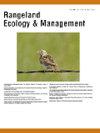Response of Cheatgrass and Other Vegetation to Proactive Management Using Two Consecutive Fall Herbicide Applications in High-Elevation Sagebrush Steppe
IF 2.4
3区 环境科学与生态学
Q2 ECOLOGY
引用次数: 0
Abstract
Nonnative plants are one of the foremost concerns to public and private land managers. To help guide managers, conservation and nonnative plant management methodologies have been blended to help prioritize management under the “defend the core” management framework. This approach emphasizes the need to control low-abundance infestations of nonnative plants before they become costly to manage and result in irreversible ecosystem alterations. However, few studies have explored the impacts and efficacy of nonnative plant management when target species occur in low abundance. Our study focused on one of the most prolific invaders in the western United States, cheatgrass (Bromus tectorum). We found that at the northern edge of cheatgrass's historical range, two consecutive fall applications of the herbicide imazapic (Plateau; BASF Corporation, Research Triangle Park, NC) controlled low-abundance populations of cheatgrass for three or more years. However, cheatgrass reductions did not result in an increase in native plant richness, native plant abundance, or native perennial grass productivity, and ultimately, cheatgrass returned to pretreatment abundances in one of two areas. As a result, we conclude that imazapic can be an effective tool to control cheatgrass when it occurs at low abundance in high-diversity plant communities, i.e., “core” sagebrush areas, within the Middle Rockies ecoregion. To defend the core, we recommend herbicide as a tool within a broader adaptive and integrated management plan that includes alterations to factors that managers can control, e.g., stocking rates, timing, placement of grazing infrastructure, and off-road travel. Lastly, we suggest that monitoring should be conducted throughout the management process so managers can adapt to the real-time responses of plant communities.
高海拔山艾草草原连续两次施用除草剂对草地和其他植被的响应
外来植物是公共和私人土地管理者最关心的问题之一。为了帮助指导管理人员,保护和非本地植物管理方法已经混合在一起,以帮助在“捍卫核心”管理框架下优先管理。这种方法强调需要控制外来植物的低丰度侵扰,以免它们变得管理成本高昂并导致不可逆转的生态系统改变。然而,很少有研究探讨当目标物种发生在低丰度时,外来植物管理的影响和效果。我们的研究集中在美国西部最多产的入侵者之一,骗草(Bromus tectorum)。我们发现,在黄草历史分布范围的北部边缘,连续两次秋季施用除草剂imazapic (Plateau;北卡罗来纳州三角研究园的巴斯夫公司(BASF Corporation)对低丰度的草种群进行了三年或更长时间的控制。然而,欺骗草的减少并没有导致本地植物丰富度、本地植物丰度或本地多年生草生产力的增加,最终,欺骗草在两个区域之一恢复到预处理丰度。结果表明,在中落矶山脉生态区内,当欺骗草在高多样性植物群落(即“核心”山艾树区)以低丰度发生时,imazapic可以作为一种有效的控制工具。为了保护核心,我们建议将除草剂作为更广泛的适应性和综合管理计划中的工具,该计划包括改变管理者可以控制的因素,例如放养率、时间、放牧基础设施的放置和越野旅行。最后,我们建议在整个管理过程中进行监测,以便管理人员能够适应植物群落的实时响应。
本文章由计算机程序翻译,如有差异,请以英文原文为准。
求助全文
约1分钟内获得全文
求助全文
来源期刊

Rangeland Ecology & Management
农林科学-环境科学
CiteScore
4.60
自引率
13.00%
发文量
87
审稿时长
12-24 weeks
期刊介绍:
Rangeland Ecology & Management publishes all topics-including ecology, management, socioeconomic and policy-pertaining to global rangelands. The journal''s mission is to inform academics, ecosystem managers and policy makers of science-based information to promote sound rangeland stewardship. Author submissions are published in five manuscript categories: original research papers, high-profile forum topics, concept syntheses, as well as research and technical notes.
Rangelands represent approximately 50% of the Earth''s land area and provision multiple ecosystem services for large human populations. This expansive and diverse land area functions as coupled human-ecological systems. Knowledge of both social and biophysical system components and their interactions represent the foundation for informed rangeland stewardship. Rangeland Ecology & Management uniquely integrates information from multiple system components to address current and pending challenges confronting global rangelands.
 求助内容:
求助内容: 应助结果提醒方式:
应助结果提醒方式:


